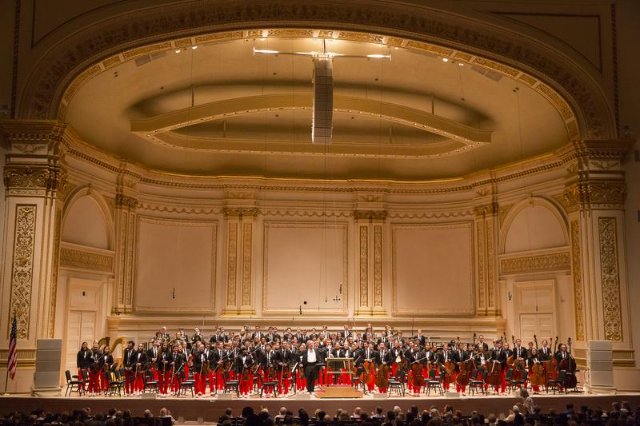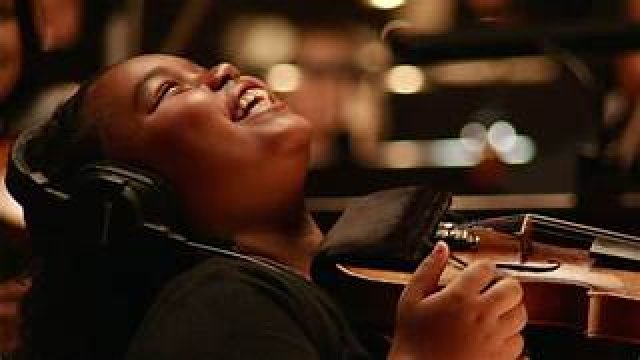Carnegie Hall Supports Young Musicians
Nezet-Seguin Conducts the National Youth Orchestra of the USA-Alumni
By: Susan Hall - Mar 18, 2024
The National Youth Orchestra-USA Alumni performed works by George Gershwin and Dmitri Shostakovich at Carnegie Hall. Yannick Nezet-Seguin conducted. Daniil Trifonov performed Gershwin’s Piano Concerto in F with flair, flash and deep feeling.
The National Youth Orchestra was organized by the Weill Institute of Carnegie Hall a little over a decade ago. It is modeled on the National Youth Orchestra of Great Britain. One hundred ten 16-19 year olds are residents at SUNY Purchase for two weeks during the summer. This is followed by a national or international tour.
The alumni musicians on stage at the Stern Auditorium are a product of years of development in the Carnegie Hall system. Many of them now perform in major orchestras throughout the world. Those who give up music as a career are among the top candidates for medical school and also form the foundation of new audiences for classical music.
What does their training give them? A sense of confidence. Of discipline. And of a lifetime joy of music.
Both works performed are challenging. In the Gershwin, the orchestra performs an equal role with the soloist. This is less a dialogue than an embedding of the piano in the orchestra. The balancing act required to meld the elements without losing either of them was masterfully undertaken under Yannick Nezet-Segin’s direction.
Gershwin wrote at the time of the Weimar Republic, whose music Carnegie is exploring this spring. Rhapsody in Blue, perhaps his most performed work, was written in ten days and is now called a white-washed version of Harlem’s vibrant Black scene. The Concerto has had a different fate, in part because it is a considered work and orchestrated by Gershwin himself.
Shostakovich’s popular Seventh Symphony followed the interval. Throughout the work instrumental soloists are featured performing phrases which they pass off one to the other. Sectional leaders give us a rich sense of the talents of these NYO-USA alumni. The piccolo flute, clarinet, and bassoon give individual colors to a work that is most often quiet, but can launch into raucous moments close to noise which look like fun to perform. The snare drum paces the rhythm compulsively.
In the second movement, fiery high notes on the violins are contrasted with concerned basses. The oboe solo carries us to another place, perhaps Leningrad in all its pacific beauty. The bass clarinet shows us dark, rich colors appearing here and in the third section. Plucked violas and harps picked up the rhythm of the drums.
In the finale, the snare drum sounded like the fire of machine guns. The brass explodes And then there is quiet, before the smashing climax.
The Orchestra brought forth a difficult two-part message with a sensitivity to music which marches like an army and also growls in dislocated notes, sometimes roaring its disapproval of the other stream of notes. Surely the presence of Nezet-Seguin and his consummate artistry helped the musicians to take hold of irony in music, a term more often associated with literature.
Shostakovich has been called a ‘holy fool’, a familiar figure in Russia. The stance offers the composer a chance to celebrate and criticize at the same time. Under pressure from a repressive political regime, Shostakovich had to kow-tow to survive. He did this while sending messages underneath a military drum beat. Keeping these two central threads alive in the 7th Symphony, these National Youth Orchestra-USA alumni under Nezet-Seguin, picture the survival plan of artists (and audience) in treacherous political times. Threats emerge from the music.
Words cannot express what music means to young people who get a chance to learn and perform. Yet the expression of the twelve-year- old Porchè Brinker at the opening and conclusion of this year's Academy Award winning short documentary tells it all.
The film, The Last Repair Shop, is the story of musicians and technicians who keep 80,000 musical instruments in working order for the Los Angeles public school system. Porchè Binker’s smile radiates more love in clasping her violin than she does with the Oscar in her arms. This expresses the impact of music on young people. The NYO-USA alumni performing at Carnegie Hall give a collective punch to this insight.


